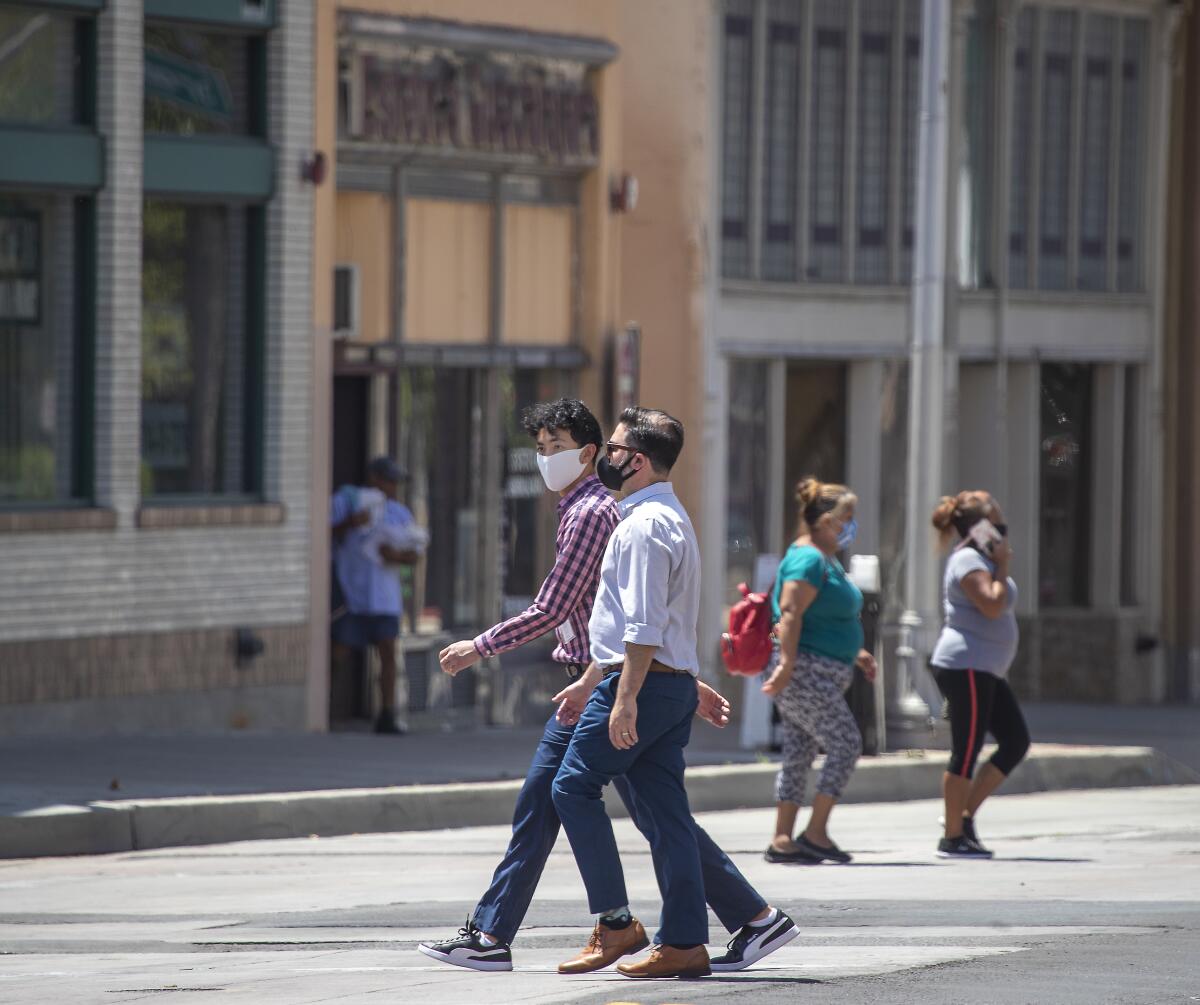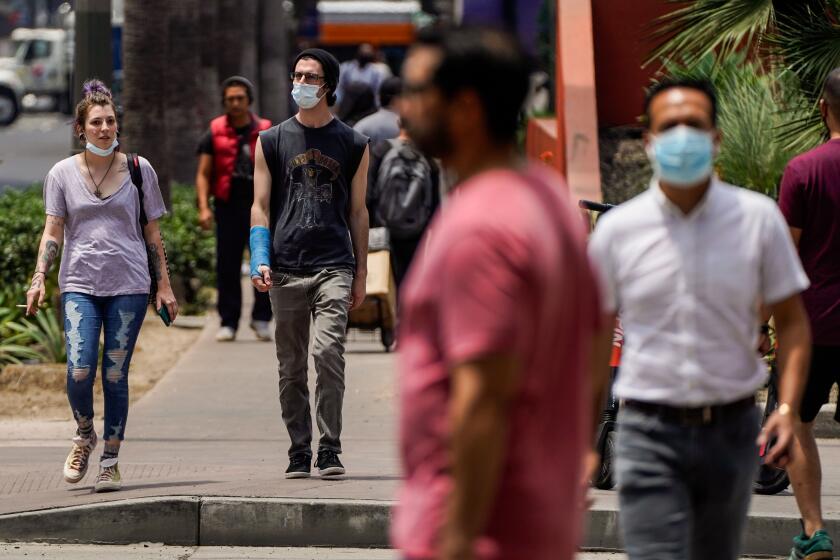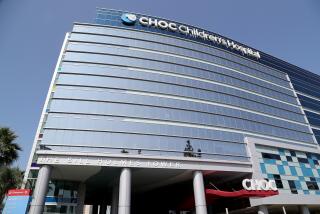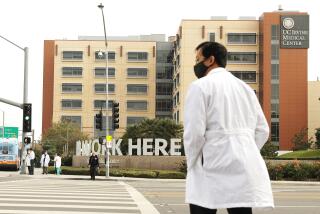Coronavirus hospitalizations jump 97% in Orange County in less than a month

The number of patients hospitalized with confirmed coronavirus infections reached new heights Thursday in Orange County — jumping 97% over the past three weeks — an indicator that health experts say makes it clear the virus is spreading more rapidly in the region.
County health officials on Thursday reported that 691 patients were being hospitalized with confirmed coronavirus infections. Seven days earlier, 556 people were hospitalized. A week prior there were 437 people in hospitals, and a week before that there were 351.
The spike has prompted hospitals countywide to begin to prepare for a surge of sick patients, said Orange County Health Care Agency Director Dr. Clayton Chau.
“These trends are very concerning and we can expect the impact on our healthcare system to get worse in the coming days and weeks,” Chau said. “If the surge goes up to or beyond their capacity to mobilize resources, that will cause a real strain. A strain on the hospital systems means a strain on the ability to care for all patients, both COVID-19 and non-COVID-19 folks.”
As of Wednesday, hospitals reported that 27 patients were from out of the county, including 18 patients from Imperial County whose hospital system has been overwhelmed amid the pandemic.
The increase in hospitalizations comes as the number of new infections continues to rise in Orange County. On Thursday, health officials reported 1,292 new coronavirus cases, bringing the total number of infections to 21,517. Officials also reported 26 fatalities, pushing the county’s death toll past 400.
While those numbers help paint an overall picture of the virus’ toll on the region, Dr. Shruti Gohil, associate medical director of epidemiology and infection prevention at UC Irvine, has kept her eye trained specifically on hospitalization numbers, which experts say is a better indicator of severe cases in the community.
“If you look at the number of people who are requiring hospitalization, it gives you a better sense of the tip of the iceberg,” Gohil said. “There’s a larger portion of the population under that tip that indicates widespread community transmission.”
The number of people in intensive care units has also continued to climb steadily countywide, though not as quickly as overall hospitalizations. As of Thursday, 234 patients were being treated in intensive care units. Three weeks earlier there were 149 patients, according to county data.
This is probably the result of an increase in infections among younger people who are less likely to end up severely ill and a sign that doctors have become better equipped to identify COVID-19 patients earlier and start caring for them more promptly, officials say.
Gohil noted that Orange County’s increasing hospitalization numbers correlates directly with the loosening of stay-at-home restrictions that allowed indoor dining at restaurants to resume and bars to reopen last month.
“If you look carefully, it’s right within that incubation period,” Gohil said. “In my mind, the restaurants and bars reopening really sent this psychological message that things were OK. People started going out more and it provided a more level playing field for this virus to infect people.”
‘Making sure we don’t have to go farther and close more businesses requires an individual commitment of each and every one of us,’ Mayor Garcetti says.
Last week, the county was forced to close bars, indoor dining at restaurants and a swath of other business sectors amid the uptick in infections and hospitalizations. The new rules, which were mandated by the state, will remain in place for at least two more weeks, officials have said.
The surge in new cases and the recent rollback of business reopenings has prompted Supervisor Michelle Steel to repeatedly appeal to residents to wear a face covering when in public. Steel, along with other members of the county’s Board of Supervisors, had previously questioned the necessity of the county’s mask requirement.
The debate became so vitriolic that Orange County’s public health officer resigned in early June after weeks of verbal attacks from the public, including a death threat, over the mandatory mask rules. Chau, her replacement, rescinded the rules amid intense pressure from the Board of Supervisors, instead “strongly recommending” that residents wear face coverings when in public.
“Stopping the spread of the virus will require following hygiene and social distancing guidance,” Steel said Thursday. “The pandemic has impacted our daily lives in ways we couldn’t have imagined a few months ago. The responsibility to protect public health is on each of us, so our friends and neighbors can responsibly go to work. We all need to do our part during these uncertain times.”
County Chief Executive Frank Kim defended the county’s messaging about masks, saying officials have always encouraged the use of face coverings and that the “county has been very consistent” in that regard.
Other counties in Southern California are also seeing a sharp uptick in hospitalizations.
Scientists are finding evidence that blood type may be a risk factor for COVID-19. In one study, people with Type A blood were more likely to be hospitalized.
In Los Angeles County, the number of patients with confirmed coronavirus infections jumped from 1,429 to 2,037 in the last three weeks, marking an increase of about 42%.
“Our three-day average of people being hospitalized is now over 1,900 patients,” Los Angeles County Public Health Director Barbara Ferrer said Wednesday. “This is more people hospitalized each day for COVID-19 than really at any other point in the pandemic.”
Riverside County’s hospitalization numbers grew from 285 three weeks ago to 506 this week — an increase of about 77%. San Bernardino County saw an even sharper increase — roughly 119% — over the same time period.
In the past two weeks, the state overall has seen a 44% increase in the number of COVID-19 patients who need hospital care.
In response, hospitals are making adjustments to their operation plans by building up an inventory of personal protective equipment, testing supplies and cross-training staff members in preparation to care for more COVID positive patients, said Carmela Coyle, president of the California Hospital Assn.
“We’re going to surge differently this time,” she said Wednesday. “We’ve learned a lot in the past four months. We know that we have different tools available to care for COVID-positive patients. We’ve got therapeutics like remdesivir and others that are actually shortening the stay of those patients. We are putting fewer of those patients on ventilators.”
Despite the increased hospitalization numbers, officials have not suggested that hospitals put off elective procedures as they did at the onset of the pandemic.
“The surge is about finding a balance between caring for COVID-positive patients and continuing to care for everyone in the state of California,” Coyle said.
More to Read
Start your day right
Sign up for Essential California for news, features and recommendations from the L.A. Times and beyond in your inbox six days a week.
You may occasionally receive promotional content from the Los Angeles Times.









